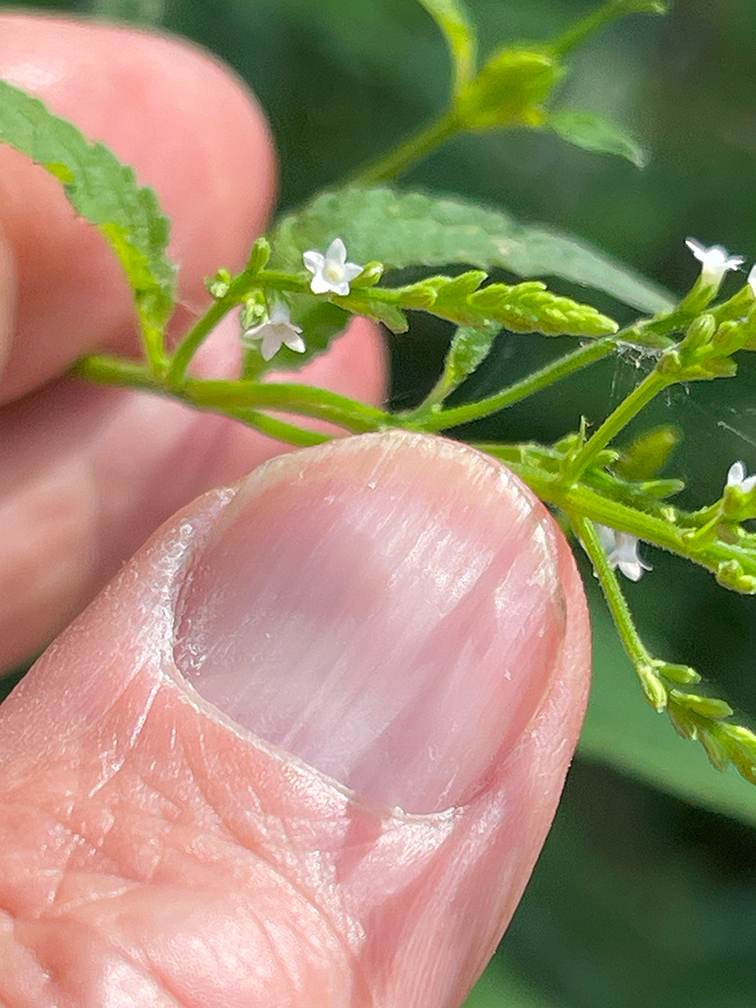
Verbena urticifolia
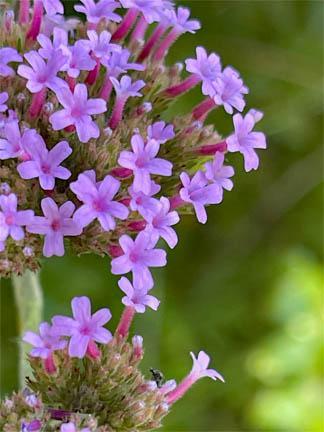
Verbena bonariensis
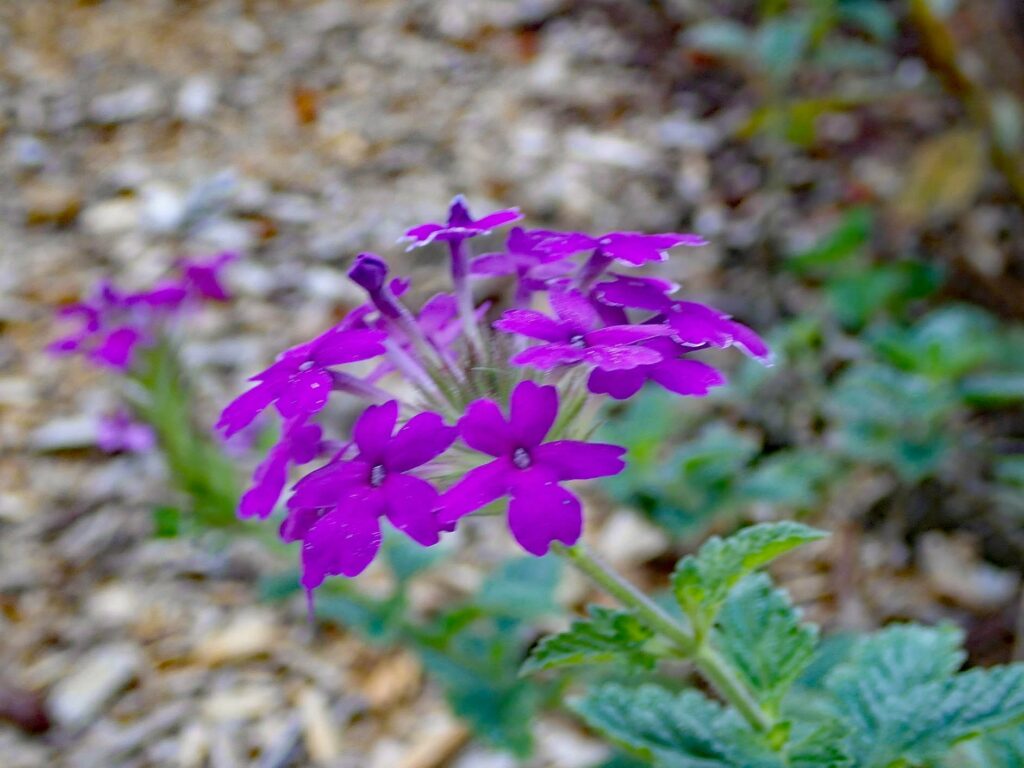
Glandularia canadensis
I thought I would develop a short write-up on the wildflower white vervain (Verbena urticifolia), which was just beginning to flower back in mid-June. What always surprises me about V. urticifolia is the small (approx. ⅛ inch) flower with 5 white petals. I went to the Digital Atlas of Virginia to confirm my identification and realized another Verbena species, the non-native Purpletop verbena (Verbena bonariensis), also grew in my yard.
Both of these Verbenas are found in open to shaded, disturbed habitats. Both plants stand tall (3 – 5 foot). I have to confess that I probably wouldn’t see either plant if I did a better job keeping the edges of the mowed areas in my yard crisp. I have enjoyed the non-native Purpletop verbena as a cut flower. The website Illinoiswildflower.info states: ‘The flowers of Purpletop Vervain are very attractive to nectar-seeking butterflies and long-tongued bees.’ The faunal associations of the native plant V. urticifolia are much more complex. White Vervain provides nectar to long and short-tongued bees, and supports larval forms of moths and beetles in addition to providing seeds for some granivorous songbirds. In my yard, neither plant is bothered by herbivores.
While re-checking the identification of the two Verbenas growing in my yard I remembered that the Northampton Free Library Pollinator Garden also features a Verbena. The library plant is low growing ( 10 – 12 inches ) and the stems spread out. It flowers (pink) early and continues all summer. But the name on the plant label in the garden did not match the live plant. I do not have the skill needed to identify the plant from printed keys, but in the Clemson Cooperative Extension article describing some Verbena species, the description of Glandularia canadensis seems to fit our library plant. It is likely the cultivar ‘Homestead Purple’ discovered growing on an old Georgia homestead based on reading the Clemson Cooperative Extension factsheet (GIC 1175). It is a low, vigorous, spreading perennial plant, sometimes referred to as “trailing verbena”, with rounded clusters of deep purple flowers.
Descriptions
Verbena bonariensis
Purpletop verbena is described by the Wisconsin Horticulture Division of Extension as an upright, clump-forming plant with wiry, widely branched stems. It reaches a height of 3 to 6 feet and spreads 1 to 3 feet. The stiff stems and branches are square and rough. The deep green, lance-shaped serrated leaves form a mounded rosette at the base of the plant, with few on the stems. The flowers are borne in rounded clusters 2 to 3 inches across. The individual flowers are little purple or rosy lavender tubes, about ¼ inch across. It blooms from mid-summer until the first frost.
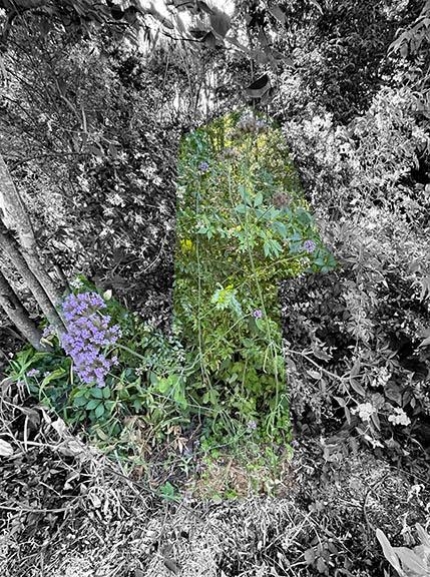
Figure 1.
Verbena bonariensis
is highlighted in color.
Susan Mahr (Wisconsin Horticulture Division of Extension) suggests that V. bonariensis should be planted in full sun and well-drained soil. It is fairly drought tolerant so doesn’t require watering once established and enjoys the heat.
Verbena urticifolia
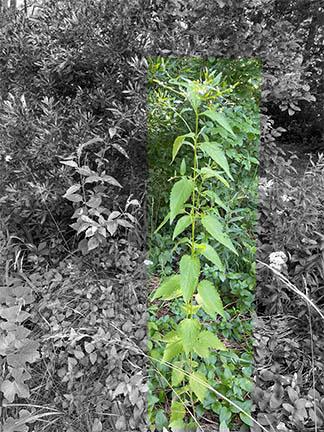
Figure 2.
Verbena urticifolia
is highlighted in color.
White vervain is an annual, biennial, or short-lived perennial. It grows to between 3 and 6 feet tall. The leaves are opposite and approximately 6 inches long and 2 ½ inches wide. They are toothed and can be slightly hairy. The flowers grow on many slender stalks from the leaf axil near the top of the plant. They are white and very small, only about 1/8″ across, with five petals.
The website, Illinois Wildflowers describes growing conditions for V. urticifolia as partial sun, moist to mesic conditions, and a fertile loam, clay-loam, or silt-loam. Illinois Wildflower suggests that White Vervain is usually found in habitats with a history of disturbance and is somewhat weedy, but rarely forms colonies, existing primarily as scattered individual plants.
Glandularia canadensis
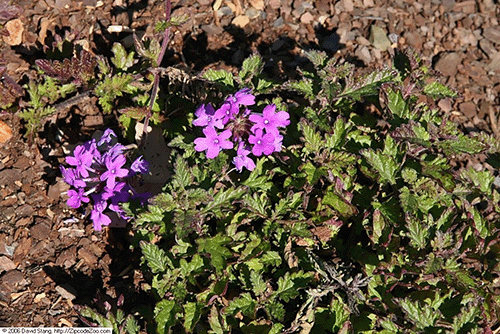
Figure 3.
Glandularia canadensis
This herbaceous perennial plant is ½–2 foot tall, often tillering (producing lateral shoots) at the base with multiple erect to sprawling stems. The stems are green and hairy, branching occasionally. The opposite leaves are 1½–3 inches long and ¾–3 inches across, becoming more narrow and slightly shorter as they ascend the stems. Quoting the Illinois Wildflowers description: “The leaves are pinnatifid and ovate to lanceolate in outline; the lower leaves are often deeply divided (cleft) into 3 primary lobes (1 terminal lobe and 2 lateral lobes), while the upper leaves are shallowly to moderately divided (cleft) into 3 or more primary lobes. The primary lobes of these leaves, in turn, are shallowly divided (cleft) into smaller secondary lobes and coarse dentate teeth. The tips of these lobes are bluntly acute. The leaf margins are slightly ciliate”. Glandularia canadensis ‘Homestead Purple’ flowers from late spring to middle fall. It is naturally found on roadsides and other dry soils preferring full sun and average to dry, well-drained soil. It is tolerant of heat, drought and coastal conditions.
Native and non-native Verbena species
Non-native species are introduced for a variety of reasons: for their ornamental nature, as a potential crop, or just plain accidentally. When these non-native species are able to take root and reproduce problems can develop. Without the competition and predation of their native lands, sometimes they are able to reproduce without any check on their expansion. This rapid expansion may result in non-native plants becoming invasive, displacing native species.
The non-native, Verbena bonariensis, has not overgrown areas of my yard over the last decade. But it is our responsibility to monitor the plants we cultivate to prevent unintended expansion.
Glandularia canadensis is not considered a native plant by the Digital Altas of the Virginia Flora. The exact words in the comment section describing this plant are “This Midwestern species is scattered in ruderal habitats of southeastern Virginia. Its nativity here is questionable ”. The Lady Bird Johnson Wildflower Center states that Glandularia canadensis is native in Virginia. The North Carolina Extension Gardener Toolbox uses the name Verbena canadensis, using the phrase “ previously known as Glandularia canadensis”. All three websites are valid sources for plant information even if they do not totally agree. This is an example of scientific conversation, a slow moving spiral of point, counter point eventually reaching consensus. My hope here is to remind us to have patience with our scientific colleagues. It took me two years to find the name for a plant. I wish it was easier, I wish I was smarter, but I am thankful for the curiosity that springs up when working in the garden.
Acknowledgement
I wish to thank fellow Extension Master Gardener Janet Rochester for her support and encouragement.
Sources
Vervains (capemaywildlife.com) Nice photos comparing purple top and white verbena Accessed 06/14/2024
Maryland Biodiversity Project – White Vervain (Verbena urticifolia) Great photos to help id plant Accessed 06/14/2024
Digital Atlas of the Virginia Flora (http://www.vaplantatlas.org) accessed 06/17/2024
Digital Atlas of the Virginia Flora | Glandularia canadensis (L.) Nutt. (vaplantatlas.org)
Digital Atlas of the Virginia Flora | Verbena urticifolia L. (vaplantatlas.org)
Digital Atlas of the Virginia Flora | Verbena bonariensis L. (vaplantatlas.org)
Verbena bonariensis – Wisconsin Horticulture Susan Mahr, University of Wisconsin accessed 06/14/2024
http://www.illinoiswildflowers.info/savanna/plants/wh_vervain.htm accessed 06/21/2024
Rose Vervain (Glandularia canadensis) (illinoiswildflowers.info) accessed 06/22/2024
https://www.wildflower.org/plants/result.php?id_plant=GLCA accessed 06/22/2024
Verbena canadensis (Clump Verbena, Rose Verbena, Rose Vervain) | North Carolina Extension Gardener Plant Toolbox (ncsu.edu) accessed 06/22/2024
Verbena | Home & Garden Information Center (clemson.edu) Accessed 06/15/2024
Original Author(s) Karen Russ, Former HGIC Horticulture Specialist, Clemson University
Revisions by: Joey Williamson, PhD, HGIC Horticulture Extension Agent, Clemson University
https://plants.ces.ncsu.edu/plants/verbena-bonariensis Accessed 06/17/2024

